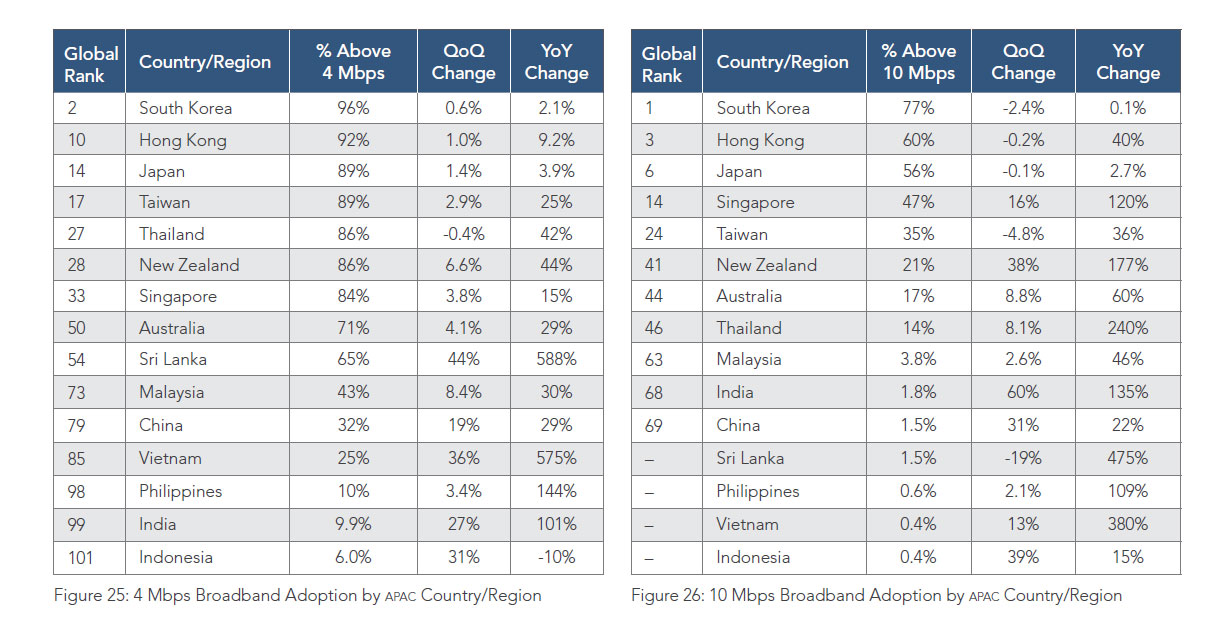Akamai’s [state of the internet] Q1 2015 report records that globally the number of Internet users has more than doubled to an estimated 3.2 billion in 2015 and the number of Internet-connected devices will outnumber the human connected population three times by 2019. In parallel with Internet usage, Internet connection speeds have improved as well. In the US, the FCC updated the broadband definition from a benchmark of 4 Mbps to 25 Mbps for downloads. Looking at connection speeds, the global average connection speed increased 10% quarter over quarter, to 5.0 Mbps, while the global average peak connection speed grew 8.2% to 29.1 Mbps.
Turning to mobile connectivity, In the first quarter, average mobile connection speeds (aggregated at a country/region level) ranged from a high of 20.4 Mbps in the United Kingdom — a 27% increase over the fourth quarter — to a low of 1.3 Mbps in Vietnam. Average peak mobile connection speeds ranged from 149.3 Mbps in Australia to 8.2 Mbps in Indonesia. Apple Mobile Safari accounted for roughly 35% of requests, down slightly from 36% in the fourth quarter, while Android Webkit and Chrome for mobile (the two primary Android browser bases) accounted for 23% and 16% of requests, respectively — giving a total of 39% for the Android platform.
Delving into the Australian landscape, it is clear we are still hampered by the recent political ructions regarding the NBN, and consequential uncertainty which has slowed commercial investment. The report suggests that more countries are migrating to a fiber to the premises model, whilst we are backpedaling to a multi-technology solution. We are being overtaken. Demand will continue to rise as VOD services such as Netflix become mainstream.
Looking at fixed line broadband connectivity, the report says at 71% of all broadband connections were above the benchmark 4bps, and this reflected a 4.1 % increase on last quarter, and a 29% lift from last year. We are now sitting at 50th globally in terms of broadband connectivity (defined as above 4Mbps). This is a drop of six places in the last quarter. We are marching more slowly than others. Turning to high speed broadband, Australia came in 44th on the global ranking, slipping three notches from last quarter at 17%. That said, there was a lift in connections above 10 Mbps by 8.8% quarter-on-quarter, and 60% year-on-year.
 The truth is that the future of broadband is more linked to mobile than ever. The report highlighted that Australia achieved the highest average peak mobile connection speeds globally in Q1 2015 at 149.3 Mbps. In addition, whilst Denmark led the field with 98% mobile internet penetration, Australia recorded the highest mobile broadband take-up rates in the Asia Pacific region at 96%. Maybe we do not need the NBN at all?
The truth is that the future of broadband is more linked to mobile than ever. The report highlighted that Australia achieved the highest average peak mobile connection speeds globally in Q1 2015 at 149.3 Mbps. In addition, whilst Denmark led the field with 98% mobile internet penetration, Australia recorded the highest mobile broadband take-up rates in the Asia Pacific region at 96%. Maybe we do not need the NBN at all?
